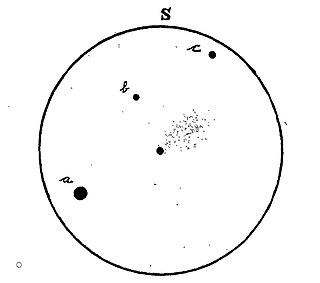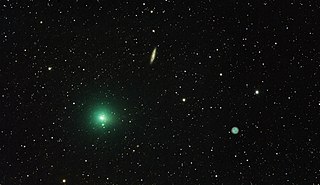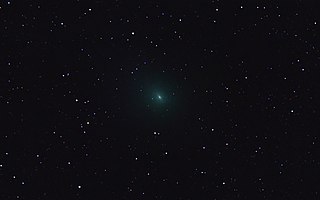
Comet Giacobini–Zinner is a periodic comet in the Solar System. It was discovered by Michel Giacobini, who observed it in the constellation of Aquarius on December 20, 1900. It was recovered two orbits later by Ernst Zinner, while he was observing variable stars near Beta Scuti on October 23, 1913.

28P/Neujmin, also known as Neujmin 1, is a large periodic comet in the Solar System. With a perihelion distance of 1.5AU, this comet does not make close approaches to the Earth.

41P/Tuttle–Giacobini–Kresák is a periodic comet in the Solar System. The comet nucleus is estimated to be 1.4 kilometers in diameter.

52P/Harrington–Abell is a periodic comet in the Solar System.

60P/Tsuchinshan, also known as Tsuchinshan 2, is a periodic comet in the Solar System with an orbital period of 6.79 years. Tsuchinshan is the Wade-Giles transliteration corresponding to the pinyin Zĭjīn Shān, which is Mandarin Chinese for "Purple Mountain".

78P/Gehrels, also known as Gehrels 2, is a Jupiter-family periodic comet in the Solar System with a current orbital period of 7.22 years.
120P/Mueller, also known as Mueller 1, is a periodic comet in the Solar System. It last came to perihelion in May 2021 and underwent a 1.4 magnitude outburst in August 2021,.
128P/Shoemaker–Holt, also known as Shoemaker-Holt 1, is a periodic comet in the Solar System. The comet passed close to Jupiter in 1982 and was discovered in 1987. The comet was last observed in March 2018.
138P/Shoemaker–Levy, also known as Shoemaker–Levy 7, is a faint periodic comet in the Solar System. The comet last came to perihelion on 11 June 2012, but only brightened to about apparent magnitude 20.5.

157P/Tritton is a periodic comet with a 6-year orbital period. Fragment B was first observed on 21 August 2022.

160P/LINEAR is a periodic comet in the Solar System. The comet came to perihelion on 18 September 2012, and reached about apparent magnitude 17.
165P/LINEAR is a periodic comet in the Solar System. 165P/LINEAR has a perihelion distance of 6.8 AU, and is a Chiron-type comet with.
170P/Christensen is a periodic comet in the Solar System. It came to perihelion in September 2014 at about apparent magnitude 18.

171P/Spahr is a periodic comet in the Solar System. 171P/Spahr was recovered on 20–24 October 2011 at apparent magnitude 20.6 using the 2.0-metre (79 in) Faulkes Telescope South. 171P/Spahr is peaked at about magnitude 18 in 2012.

Comet Finlay is a periodic comet with an orbital period of 6 years discovered by William Henry Finlay on September 26, 1886. The next perihelion passage is July 13, 2021 when the comet will have a solar elongation of 54 degrees at approximately apparent magnitude 10. It last came to perihelion on December 27, 2014, at around magnitude 10. Of the numbered periodic comets, the orbit of 15P/Finlay has one of the smallest minimum orbit intersection distances with the orbit of Earth (E-MOID). In October 2060 the comet will pass about 5 million km from Earth.
Comet Taylor, is a periodic comet in the Solar System, first discovered by Clement J. Taylor on November 24, 1915.

45P/Honda–Mrkos–Pajdušáková is a short-period comet discovered by Minoru Honda December 3, 1948. It is named after Minoru Honda, Antonín Mrkos, and Ľudmila Pajdušáková. The object revolves around the Sun on an elliptical orbit with a period of 5.25 years. The nucleus is 1.3 kilometers in diameter. On August 19 and 20, 2011, it became the fifteenth comet detected by ground radar telescope.

144P/Kushida is a periodic comet discovered in January, 1994, by Yoshio Kushida at the Yatsugatake South Base Observatory in Japan. This was the first comet discovery of 1994 and his second discovery within a month. It next comes to perihelion on 25 January 2024 and should brighten to about magnitude 9.
163P/NEAT is a periodic comet discovered on November 5, 2004 by Near-Earth Asteroid Tracking (NEAT) using the 1.2 meter Samuel Oschin telescope at Palomar Observatory.

62P/Tsuchinshan, also known as Tsuchinshan 1, is a periodic comet discovered on 1965 January 1 at Purple Mountain Observatory, Nanking. It will next come to perihelion on 25 December 2023 at around apparent magnitude 8, and will be 0.53 AU (79 million km) from Earth and 110 degrees from the Sun.



















